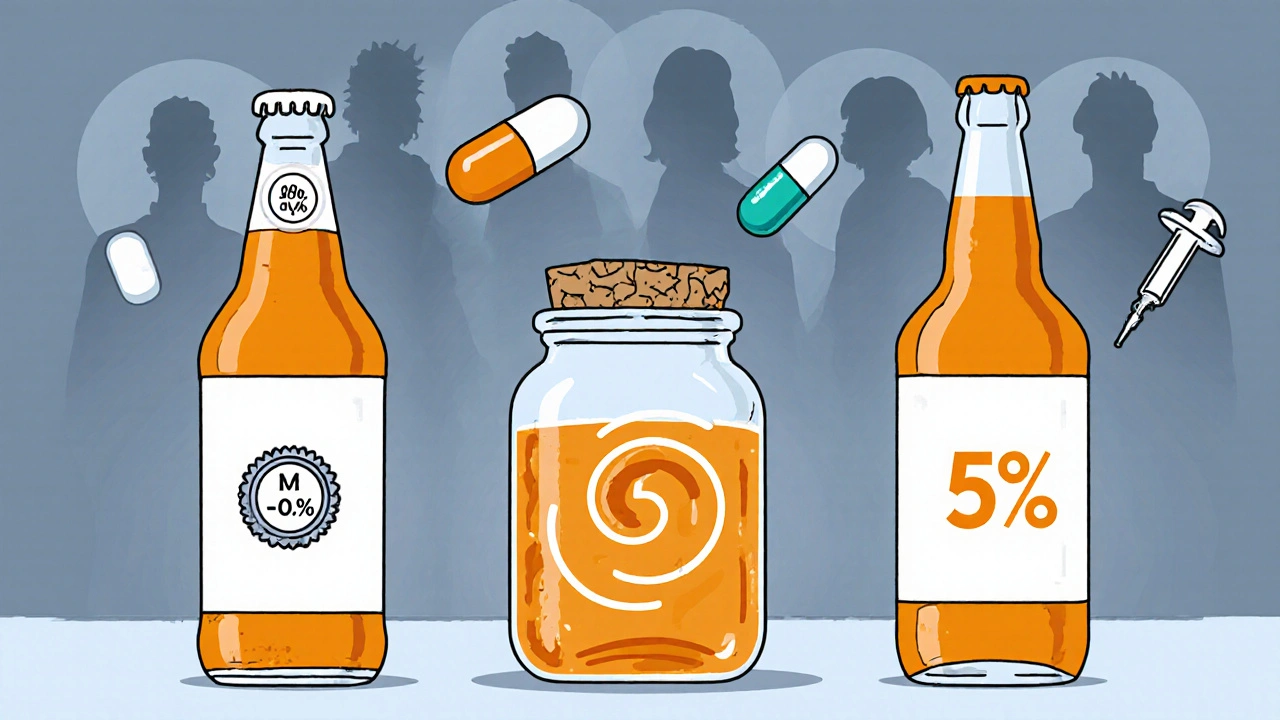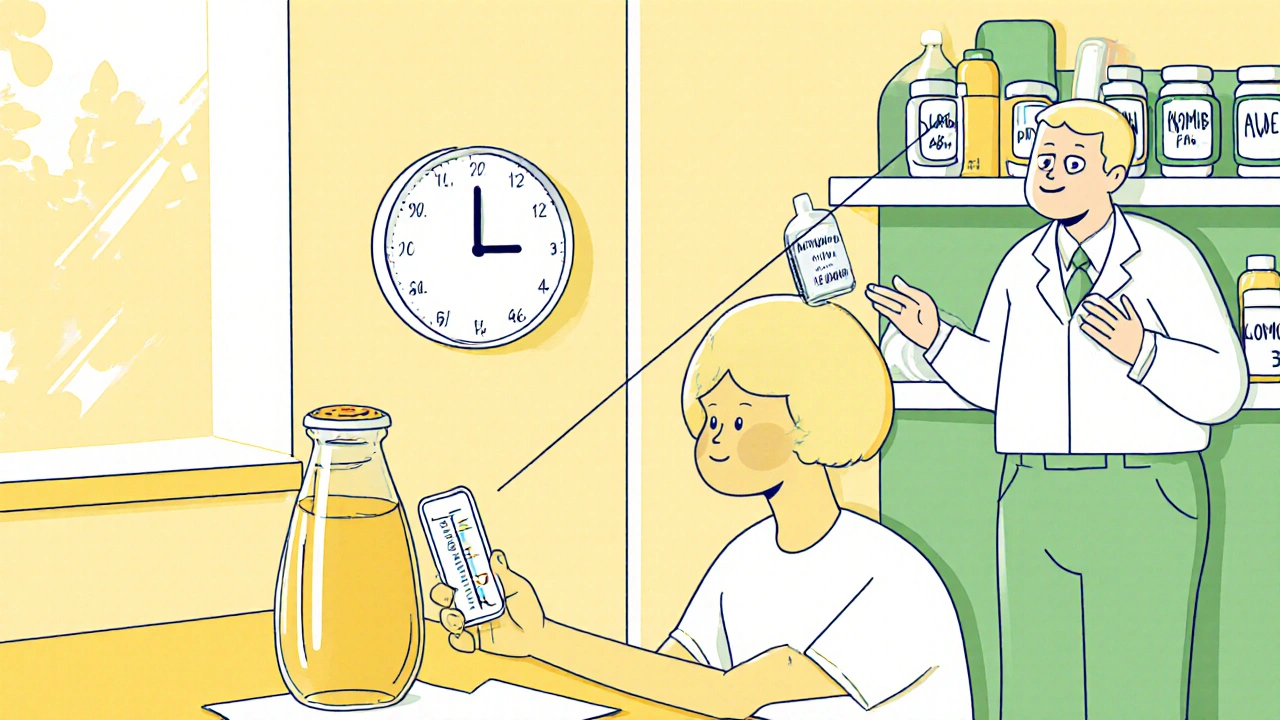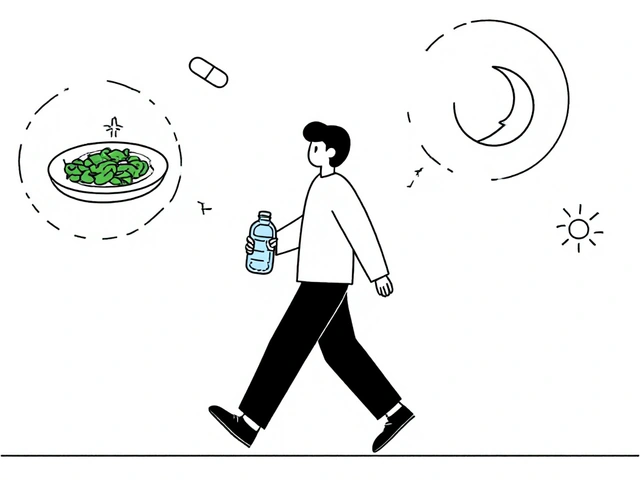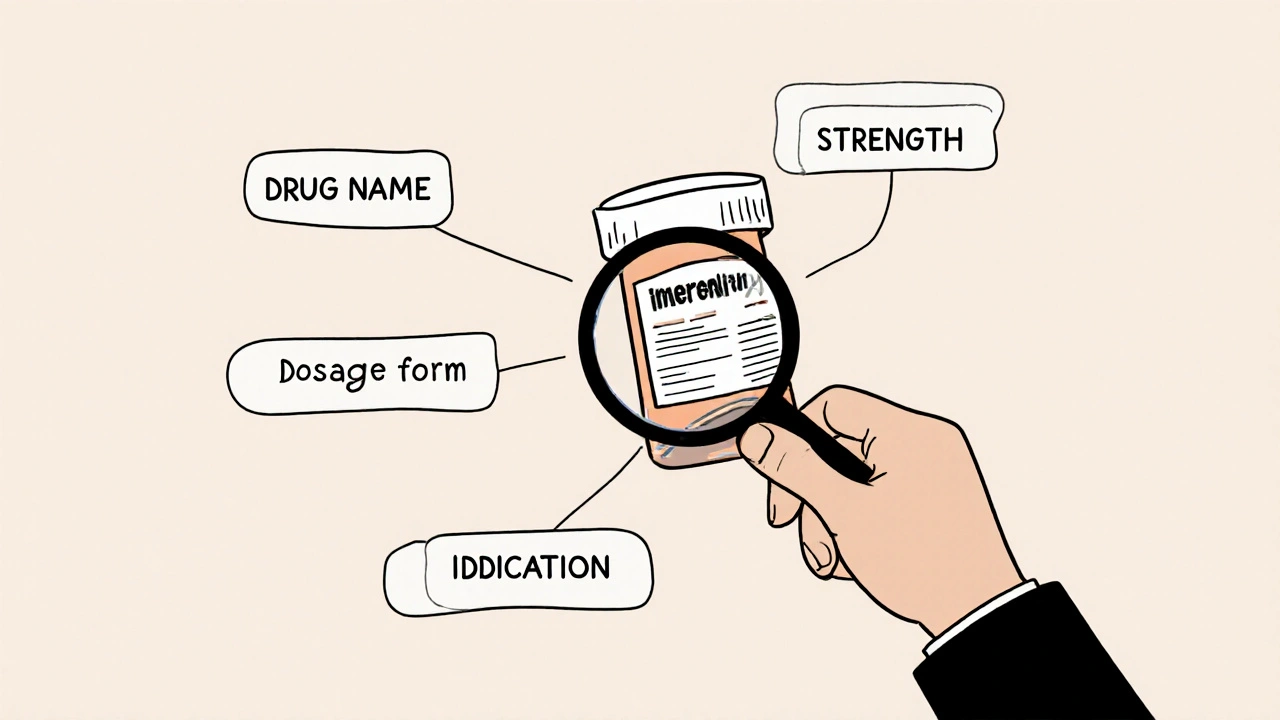Kombucha Safety Checker
Check if your kombucha is safe to consume based on its alcohol content and your medications. Note: This tool provides general guidance only. Always consult your healthcare provider for personalized advice.
Results will appear here after calculation.
When you see Kombucha is a fermented tea beverage produced by a symbiotic culture of bacteria and yeast (SCOBY). It naturally generates trace alcohol during the fermentation process. That tiny amount can matter if you’re taking alcohol‑sensitive medication, a class of drugs that react even to small alcohol doses.
Key Takeaways
- Commercial kombucha stays below 0.5 % ABV, but home‑brewed batches can reach 2.5 % or more.
- Even trace alcohol can worsen side‑effects of antibiotics, benzodiazepines, SSRIs, metformin and other common drugs.
- Testing your kombucha with an alcoholmeter or HPLC gives the safest path if you brew at home.
- Leave at least 48 hours between taking an alcohol‑sensitive drug and drinking kombucha.
- Look for the "Contains trace alcohol" label and, when possible, batch‑specific alcohol data via QR codes.
What Is Kombucha and Why Does It Contain Alcohol?
Kombucha starts as sweetened black or green tea. The SCOBY (symbiotic culture of bacteria and yeast) consumes the sugar, producing organic acids, carbonation, and a small amount of ethanol as a by‑product. The yeast component ferments sugars into ethanol, while bacteria convert much of that ethanol into acetic acid, which gives kombucha its tangy flavor.
The amount of ethanol depends on temperature, sugar level, and how long the brew sits. At the optimal yeast temperature of 75‑85 °F (24‑29 °C), ethanol production spikes, especially during the later days of primary fermentation.
How Alcohol Levels Vary: Commercial, Homebrew, and Hard Kombucha
Regulators define "non‑alcoholic" as ≤0.5 % ABV. Commercial brands must test each batch and keep the number under that threshold, often using flash pasteurization or membrane filtration to stop yeast activity. The FDA and TTB enforce these limits, and 92 % of commercial producers now run HPLC or gas‑chromatography tests on every lot.
Home‑brewed kombucha is a different story. A 2023 study of 150 home batches recorded ABV from 0.5 % up to 2.5 %, with the highest numbers appearing in batches left at 80 °F for 14 days without oxygen restriction. The variability is roughly three times greater than in commercial products.
Hard kombucha is intentionally brewed to contain 3‑8 % ABV, placing it in the same category as light beer. These products undergo a secondary fermentation with extra sugar and are labeled as alcoholic beverages, requiring full alcohol‑content disclosure.
| Type | Typical ABV | Regulatory Status | Interaction Risk |
|---|---|---|---|
| Commercial (non‑hard) | ≤0.5 % | Non‑alcoholic under TTB | Low but not zero |
| Homebrew | 0.5‑2.5 % | Varies; often unregulated | Moderate to high |
| Hard kombucha | 3‑8 % | Alcoholic beverage; requires label | High |

Medications That React to Even Small Amounts of Alcohol
Pharmacology agencies list 17 medication classes that flag "contains alcohol" warnings. The most common culprits are:
- Metronidazole and other nitro‑imidazole antibiotics - can cause severe nausea, vomiting, and flushing when ethanol exceeds 0.5 % ABV.
- Benzodiazepines (e.g., diazepam, lorazepam) - ethanol enhances GABA receptor activity, deepening sedation and respiratory depression.
- Selective serotonin reuptake inhibitors (SSRIs) such as sertraline - combined alcohol can increase dizziness and impair judgment.
- Diabetes drugs (e.g., metformin, chlorpropamide) - alcohol can trigger hypoglycemia, sometimes requiring emergency care.
- Nitrates for angina - ethanol may cause sudden blood‑pressure drops.
Even a "standard drink" equivalent of 1.75 % ABV per week (the amount you get from drinking a 250 ml bottle of 0.5 % kombucha daily) can push some patients over the safe limit, especially older adults on multiple drugs.
Testing and Verifying Alcohol Content in Kombucha
If you brew at home, the cheapest reliable tool is an alcoholmeter (e.g., HM Digital HA‑520). It reads specific gravity and translates that into % ABV with ±0.1 % accuracy. To use it:
- Cool the kombucha to room temperature - temperature skews readings.
- Degas the sample by gently swirling to release CO₂.
- Fill the meter’s test tube, snap it into the device, and read the scale.
- Record the value for each batch; aim for ≤0.5 % if you take alcohol‑sensitive meds.
For commercial lovers who want batch‑specific data, look for QR codes that link to a transparency portal (e.g., Health‑Ade’s “Transparency Project”). These often show the exact ABV measured by HPLC, the gold‑standard laboratory method.

Practical Guidelines for Safe Consumption with Alcohol‑Sensitive Drugs
Here’s a step‑by‑step safety plan you can adopt:
- Identify whether any of your prescriptions list an alcohol interaction. The label usually reads “Do not consume alcohol” or “Avoid alcoholic beverages.”
- Check the label for a “Contains trace alcohol” statement. If it’s missing, assume the product could exceed 0.5 %.
- Time it right: the Cleveland Clinic recommends a minimum 48‑hour gap between taking an alcohol‑sensitive medication and drinking kombucha.
- Test homebrew before each consumption if you brew yourself. Aim for ≤0.5 % ABV; if higher, either discard or wait until the alcohol evaporates (which can take weeks).
- Monitor symptoms. If you feel unusual nausea, dizziness, or a sudden blood‑sugar dip after drinking kombucha, stop and contact your pharmacist.
Pharmacies such as CVS and Walgreens now display warnings on kombucha shelves in about 78 % of locations, but only 32 % of pharmacists correctly identify it as an alcohol source. When in doubt, ask the pharmacist directly.
Labeling, Regulations, and What to Look For on the Bottle
Since January 2024 the FDA requires every kombucha product sold in the U.S. to carry a “Contains trace alcohol” statement. The wording is standardized: “This product contains less than 0.5 % alcohol by volume.” However, studies show 63 % of brands still omit the warning on the front label, putting it only on the back or in tiny print.
Internationally, the UK Food Standards Agency follows similar guidance: any drink with >0.5 % ABV must be labeled as an alcoholic beverage. If you’re buying abroad, check the ingredient list for “fermented tea” and the nutritional facts for an “Alcohol” line.
For hard kombucha, the label will list the exact ABV (e.g., 5 %). These are subject to the same nutrition labeling rules as beer, meaning you’ll see a standard alcohol warning.
Frequently Asked Questions
Can a 0.5 % ABV kombucha trigger a reaction with metronidazole?
Yes. Clinical reports show that even the legal limit of 0.5 % can cause a disulfiram‑like reaction in sensitive patients. If you’re on metronidazole, avoid all kombucha unless you have a lab‑verified ABV of 0 %.
How accurate is an alcoholmeter compared to HPLC?
An alcoholmeter gives a quick estimate with ±0.1 % error, which is sufficient for most home‑brew safety checks. HPLC is more precise (±0.01 %) and is used by commercial labs, but it’s cost‑prohibitive for most hobbyists.
Do hard kombucha brands have to list the exact ABV?
Yes. Because they exceed the 0.5 % threshold, they are classified as alcoholic beverages and must display the precise ABV on the front label, just like beer.
Is it safe to drink kombucha while taking SSRIs?
Caution is advised. SSRIs can amplify ethanol’s sedative effect, leading to increased dizziness. Stick to kombucha under 0.5 % ABV and keep a 48‑hour gap after your dose.
What should I do if I accidentally drink high‑ABV homebrew?
Stop drinking immediately, hydrate with water, and monitor for symptoms such as nausea, dizziness, or rapid heart rate. If you’re on a medication that reacts with alcohol, contact your healthcare provider right away.
The kombucha alcohol interaction isn’t a myth-trace alcohol can change how your drugs work. By checking labels, testing home batches, and spacing out consumption, you can enjoy the probiotic benefits without risking unwanted side effects.





Comments
7 Comments
Miracle Zona Ikhlas
If you’re on any of those meds, just keep a 48‑hour window between your dose and the kombucha. A quick glance at the label can spare you a nasty interaction.
naoki doe
Honestly, it’s wild how many people just ignore the tiny alcohol content because it “looks like soda.” You should really treat kombucha like any other fermented drink when you’re on sensitive meds.
Carolyn Cameron
It is incumbent upon the discerning consumer to recognize that even a nominal ethanol presence, albeit sub‑legal, may engender pharmacodynamic augmentation, particularly with agents such as metronidazole or benzodiazepines. Hence, a scrupulous review of the product’s analytical certificate is advisable.
Charlene Gabriel
One of the most common misconceptions about kombucha is that “trace” alcohol is harmless, but the reality is far more nuanced. The fermentation process is a delicate balance between yeast and bacteria, and subtle shifts in temperature or sugar can tip that balance toward higher ethanol yields. When you’re juggling a regimen that includes SSRIs or metronidazole, even a half‑percent of alcohol can alter the expected metabolism of the drug. Studies have shown that ethanol can inhibit certain hepatic enzymes, leading to elevated plasma levels of the co‑administered medication. This pharmacokinetic interaction can manifest as intensified side‑effects, ranging from mild dizziness to severe disulfiram‑like reactions. Moreover, the cumulative effect of daily consumption, even at low ABV, can add up over weeks, especially in older adults with reduced clearance capacity. The FDA’s 0.5 % threshold is a regulatory compromise, not a medical safety guarantee for those on alcohol‑sensitive drugs. Home‑brewed batches, unfortunately, often exceed that limit without the consumer’s knowledge, because most hobbyists lack access to professional HPLC testing. An alcoholmeter, while affordable, only offers ±0.1 % accuracy, which may still leave a risky margin. If you’re uncertain, the safest course is to treat any kombucha as if it contained at least 1 % alcohol and adjust your medication timing accordingly. A practical rule of thumb is to maintain a 48‑hour gap between taking the medication and sipping the brew, as recommended by several clinical guidelines. Additionally, always scan QR codes on commercial bottles; many brands now provide batch‑specific analysis data. If you notice any unexpected symptoms after drinking kombucha-such as sudden nausea, a drop in blood sugar, or heightened sedation-contact your pharmacist promptly. Remember, the goal is to enjoy the probiotic benefits without compromising your treatment plan. By staying vigilant and employing simple testing methods, you can safely incorporate kombucha into a well‑managed health routine.
Leah Ackerson
✨Your breakdown hits the nail on the head-people treat kombucha like harmless juice, but the chemistry doesn’t lie. 🍵 When we skip the testing step, we gamble with our meds, and that’s a risk no one needs. 🙅♀️
Gary Campbell
What they don’t tell you is that the “trace alcohol” label is a smokescreen engineered by big pharma to keep the public from discovering how easily they can manipulate drug efficacy through everyday beverages.
renee granados
Enough of the theories-just test your brew and keep a safe gap. No need to dramatize.
Write a comment